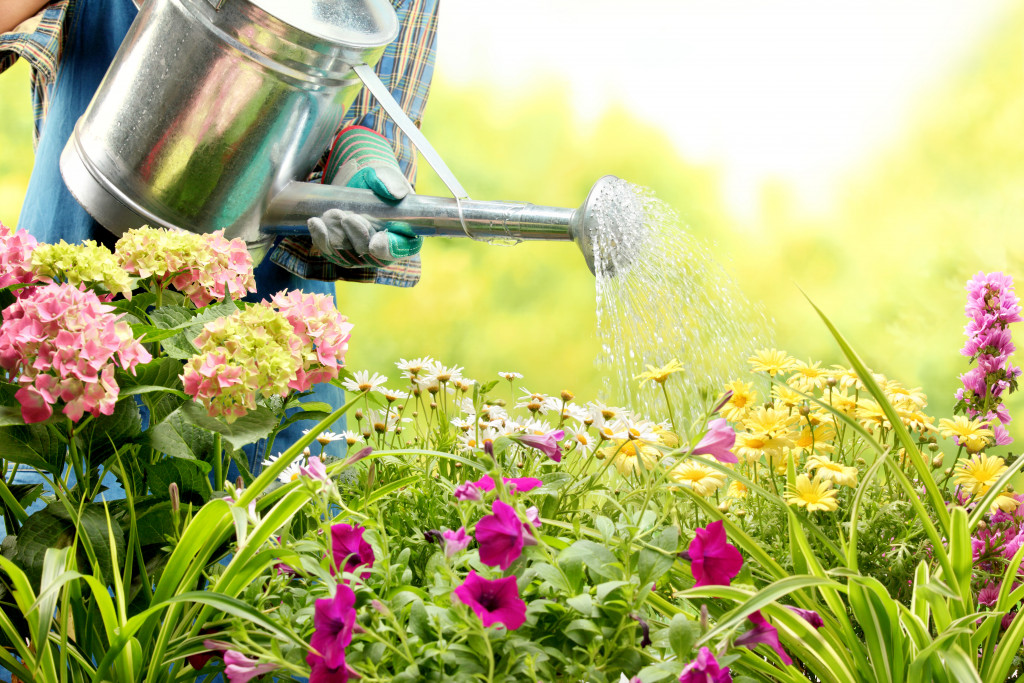By summer’s end, you may have one of two feelings about your garden. Either it is a resplendent wonderland or an over-grown jungle replete with fading blooms and thirsty foliage.
No matter how grand the subject of your desires this year, all gardens will eventually suffer from neglect, whether through lack of time, waning interest, or the simple fact that Mother Nature is conspiring to smother your dreams of green with frost and chill.
With a little pre-planning, you can avoid the heartbreak of an unattended garden and keep it looking beautiful all year round. Read on for the top ways to keep your garden beautiful and blooming, whatever the weather.

1. Plant Perennials
While annuals are popular for quick results and easy care, they ultimately need more work than perennials. The latter bloom only once but live longer (some even come back each spring), require less water (depending on their root structures), and spread beautifully, filling borders without any assistance from you.
Planting perennials is an easy, cost-effective way to keep your garden looking beautiful with very little upkeep. They can act as ground cover by tucking themselves next to rocks or shrubs and won’t smother smaller plants either!
Hanging baskets are another great option for filling empty spaces that require more than just a spritz of water now and then.
2. Stop Weeding
It might sound blasphemous, but this is the secret most often overlooked by amateur gardeners everywhere. If left alone, many weeds will stay where they sprouted, hidden beneath larger plants or tucked into pockets where they will never be seen.
The trick here is patience: wait until after their first bloom cycle, when their seeds have dispersed, then cut them back to the ground. This signals to the roots that they need to develop further and stop them from returning next year.
If you end up dealing with lots of dead weeds after cutting them, use battery-operated leaf blowers to quickly and easily remove the leaves without dirtying your hands and annoying the neighbors.
3. Create Plant Divisions
Plants are fast growers and will outgrow their assigned spaces within a season if not divided. Divide them into smaller sections with a shovel or trowel, ensuring you cut through any visible roots to avoid future overcrowding.
You can also divide flowerbeds annually to keep them looking beautiful by removing sections that have finished blooming or dividing older plants into multiples before they begin overtaking other areas.
If you live in an area where the soil is particularly poor quality (i.e., clay), raised beds are perfect for preventing water overflow and promoting healthy, nutrient-rich soil while keeping your plants segregated.
4. Pay Attention to Hardiness Zones
Not all plants are created equal, especially when you take into consideration where they originate from. Areas with harsh winters will see an end to many delicate specimens ill-equipped for the cold, resulting in dead blooms and flimsy foliage.
Before purchasing any new plants, check your hardiness zone (most are listed right on the plant label) and look for plants native to your area instead. They require less TLC because they already know how to deal with your weather conditions.
Also, look for plants that have been pre-treated to resist frost and snow, as well as those labeled “tender,” which need a little extra protection from the cold.
5. Keep Your Lawn in Check
Even if your front lawn is meant to be a “free space” where you can let pets run around or throw a ball with the kids (without them ever touching your prized flowers), it still needs attention now and then.
Fall is by far the best time of year to get outside and start cutting away at your lawn without doing too much damage. Use weed eaters instead of scissors on thick grass or invest in an electric mower (and spare yourself the colorful language of gas mowers). If you’re upgrading your lawnmower, keep the grass length at two and a half to three inches tall for fertilization purposes.
6. Add Texture and Color
The secret to a beautiful garden is in the details, so take time when planning what you plant. Flowers are lovely, but consider adding some greenery to your borders with grasses or moss sown into the spaces between plants. These offer food for birds that will keep your space pest-free while providing interesting textures that bring life to bare areas.
If you’d prefer another low-maintenance option, try using flowerbed edging instead. It won’t obstruct growth or break up soil beds like rocks can, either.
Garden maintenance doesn’t have to be difficult or time-consuming. Just follow these easy tips, and you’ll create a beauty that continues blooming all year round.

